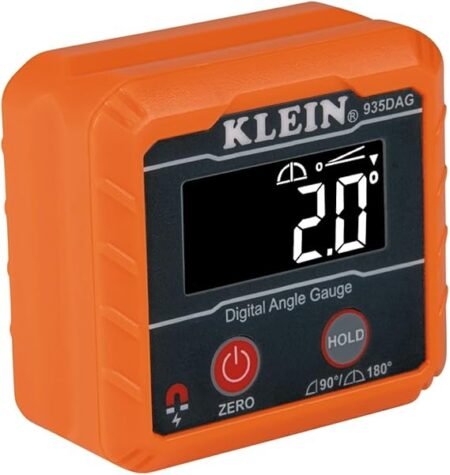
buy product
Introduction to Digital Electronic Levels and Angle Gauges
Digital electronic levels and angle gauges are specialized tools designed to provide precise measurements of angles, inclinations, and levels. These instruments have become indispensable in various fields, including carpentry, metalwork, and construction, due to their high degree of accuracy and ease of use. Unlike traditional analog tools, digital electronic versions offer more advanced features, improving both productivity and measurement reliability.
The general functionality of digital electronic levels and angle gauges centers around their ability to measure and display angles with remarkable precision. Typically, these devices are built with a durable, user-friendly interface that includes a digital readout screen, making it easy to interpret the measured angles. The core components usually consist of high-precision sensors, microprocessors, and durable housings that withstand the rigors of industrial use.
Key features that set digital electronic levels and angle gauges apart from their traditional counterparts include their ability to store measurements, perform zero calibration, and even offer hold functions to freeze readings for later use. Many models also come equipped with magnetic bases for hands-free operation on metal surfaces, enhancing their practical utility in various tasks. This combination of advanced capabilities not only ensures more accurate and consistent results but also significantly reduces the time and effort required to complete measurement tasks.
In industries where precision is paramount, such as in high-end carpentry or specialized metalwork, the importance of accurate angle and level measurements cannot be overstated. The benefits of using digital electronic tools extend beyond mere accuracy; they also promote safer and more efficient workflow practices. By minimizing errors and reducing the need for repeated measurements, these tools help professionals maintain high-quality standards while meeting project deadlines.
Overall, the adoption of digital electronic levels and angle gauges represents a significant advancement over traditional tools. Their modern features, combined with the undeniable need for accurate measurement in professional settings, make them an essential part of contemporary toolkits. As we delve deeper into their specific functionalities and applications, it becomes clear why these digital instruments have become the standard in precision measurement.
Key Features and Specifications to Consider
When choosing a digital electronic level or angle gauge, several key features and specifications are vital to ensure optimal performance and precision. Firstly, accuracy is paramount. High-end models typically offer accuracy to within 0.1 degree, providing the precision required for critical tasks. This level of accuracy ensures that measurements are reliable and consistent, a crucial aspect for professional applications.
Another significant feature is resolution. The resolution of the device dictates the smallest measurement increment that can be displayed. A resolution of 0.01 degrees is often sufficient for most professional and DIY tasks, facilitating fine-tuned adjustments. Digital display types also play a crucial role in user experience. Clear, backlit LCDs enable easy reading of measurements in varied lighting conditions, enhancing usability.
Battery life is another essential consideration. Tools with extended battery life reduce the downtime associated with frequent replacements or recharges. Modern digital electronic levels and angle gauges often feature energy-efficient designs that maximize longevity, with some models incorporating rechargeable batteries to further convenience.
Additionally, functionalities such as data hold and zero-setting are beneficial. The data hold function allows users to lock measurements on the display, which is particularly useful in situations where the level or gauge cannot be read immediately. The zero-setting function enables users to reset the device to zero at any position, facilitating relative measurements and simplifying complex tasks.
Popular brands like Stabila, Bosch, and Klein Tools offer models with these advanced features. For instance, the Stabila TECH 700 DA Digital Angle Finder boasts high accuracy and a simple, user-friendly interface. On the other hand, Bosch’s GAM 220 MF Digital Angle Finder is praised for its robust design and extended battery life. Lastly, Klein Tools’ 935DAG Digital Level showcases superior resolution and a durable build, making it a favorite among professionals.
By understanding these key features and specifications, users can make informed decisions, selecting the digital electronic level or angle gauge that best meets their specific needs and enhances their efficiency on the job.
Practical Applications and Use Cases
Digital electronic levels and angle gauges have revolutionized precision measurement across a multitude of industries. In engineering, these tools are integral for tasks requiring high accuracy. For instance, civil engineers use them to ensure that structures, like bridges and buildings, are level and meet safety standards. Digital electronic levels provide real-time readouts, enabling engineers to make immediate adjustments, thus enhancing workflow and conserving time.
In woodworking, precision is paramount. Carpenters and woodworkers rely on digital angle gauges to achieve exact cuts and alignments. These devices are especially useful when working with complex projects such as cabinetry and bespoke furniture, where the slightest deviation can result in significant errors and material waste. The ability to measure angles with remarkable precision ensures that pieces fit together perfectly, bolstering overall project quality and aesthetic appeal.
Automotive industry professionals also benefit significantly from these tools. Mechanics and automotive engineers utilize digital electronic levels and angle gauges in vehicle alignment and suspension setups. Proper alignment is crucial for vehicle safety and performance, and these digital tools provide the necessary accuracy to enhance vehicular stability and handling. Moreover, by reducing manual errors, they improve safety standards and efficiency during the diagnostic and repair process.
Case studies highlight their practical utility further. For example, in aerospace engineering, where precision margins are exceedingly tight, digital levels guarantee that each component fits within designated parameters, thus maintaining structural integrity and operational efficiency. Manufacturing plants have also adopted these tools to streamline quality control procedures, ensuring that products adhere to stringent specifications before reaching consumers.
Overall, digital electronic levels and angle gauges serve as indispensable tools across various sectors, significantly improving precision, efficiency, and safety. As technology continues to evolve, their integration into professional practices will likely expand, further solidifying their role in achieving meticulous accuracy in diverse applications.
Tips for Proper Usage and Maintenance
Digital electronic levels and angle gauges are precision instruments essential for various applications such as construction, woodworking, and machining. To achieve optimal performance and extend their longevity, it is crucial to adhere to specific usage and maintenance practices. This section provides comprehensive advice on the proper handling, calibration, storage, and routine upkeep of these tools.
Calibration Procedures
Regular calibration is fundamental in maintaining the accuracy of digital electronic levels and angle gauges. To calibrate, first, ensure the surface to be measured is clean and free from debris. Place the level or gauge on a stable, flat surface and follow the manufacturer’s instructions for calibration. Most devices have a built-in calibration function, typically involving positioning the tool in multiple orientations. Calibration should be performed periodically, particularly before critical projects, to ensure precision.
Handling and Storage Tips
Proper handling of digital electronic levels and angle gauges helps prevent damage and maintains their accuracy. When using these tools, avoid exposing them to extreme temperatures, moisture, or dust. These environmental factors can adversely affect their electronic components. After use, clean the device with a soft, dry cloth to remove any dust or debris. For storage, keep the tools in a protective case or a dedicated storage area, ensuring they are not subjected to vibrations or pressure that might alter their calibration.
Common Troubleshooting Techniques
Despite careful handling, users may occasionally encounter issues with their digital electronic levels or angle gauges. Common problems include inconsistent readings or malfunctioning buttons. For fluctuating readings, recalibration is often the solution. If buttons become unresponsive, check the battery life and replace batteries if necessary. Also, inspect the device for any visible damage. In case of persistent issues, consulting the user manual or contacting customer support may be required.
Routine Maintenance
To ensure the long-term accuracy and functionality of digital electronic levels and angle gauges, routine maintenance is essential. Regularly inspect the tools for signs of wear or damage. Clean the device periodically, paying attention to the electronic sensors and display. Ensure that the battery compartment is dry and free from corrosion. Replace batteries as needed, using only the recommended type. By following these maintenance tips, you can preserve the quality and accuracy of your digital electronic levels and angle gauges, ensuring reliable results for years to come.
buy product
Discover more from detoatepentrutotisimaimult
Subscribe to get the latest posts sent to your email.
